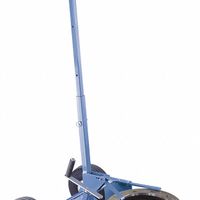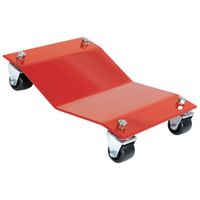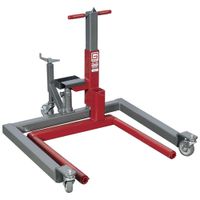Call +(254) 703 030 000 / 751 483 999 / 721 704 777
- Home
- Fleet Vehicle Maintenance
- Garage Equipment
- Garage Dollies
Garage Dollies
Garage dollies move equipment around the shop floor to limit lifting and moving heavy equipment during fleet maintenance and repair. Car dollies and accessories include parts that help move vehicles without starting engines. Wheel dollies cradle and support tire and wheel assemblies during removal a .....Read More
Frequently Asked Questions
What are garage dollies used for?
Garage dollies are versatile tools used primarily for moving and positioning vehicles or heavy equipment within a garage or workshop setting. They are designed to facilitate the easy and safe relocation of cars, motorcycles, or other heavy machinery without the need for driving them. This is particularly useful in confined spaces where maneuverability is limited.
The primary function of garage dollies is to allow a single person to move a vehicle with minimal effort. They typically consist of a sturdy platform with wheels or casters that can support the weight of the vehicle. By placing a dolly under each wheel of the vehicle, it can be rolled in any direction, making it easier to position the vehicle precisely where needed. This is especially beneficial for mechanics or car enthusiasts who need to maximize space in a garage or workshop.
Garage dollies are also used for vehicle storage. By lifting the vehicle off the ground, they help prevent tire flat spots and reduce stress on the suspension during long-term storage. This can be particularly advantageous in climates with extreme temperatures or for vehicles that are not used frequently.
In addition to vehicles, garage dollies can be used for moving heavy equipment, such as toolboxes, machinery, or large appliances. This versatility makes them a valuable asset in both professional and home garage settings.
Overall, garage dollies enhance efficiency, safety, and space management in garages and workshops, making them an essential tool for anyone who regularly works with vehicles or heavy equipment.
How do car dollies work?
Car dollies are devices used to move vehicles easily, especially in tight spaces or for towing purposes. They function by lifting the wheels of a vehicle off the ground, allowing it to be rolled or towed without the need for the engine to be running. Here's how they work:
1. **Types of Car Dollies**: There are two main types: tow dollies and wheel dollies. Tow dollies are used for towing vehicles, lifting the front wheels off the ground, while the rear wheels roll on the road. Wheel dollies, on the other hand, are used for maneuvering vehicles in garages or workshops, lifting all four wheels off the ground.
2. **Construction**: Car dollies typically consist of a sturdy metal frame with wheels or casters. Tow dollies have a platform for the vehicle's front wheels and are equipped with a hitch to attach to a towing vehicle. Wheel dollies have a cradle or platform for each wheel of the vehicle.
3. **Operation**:
- **Tow Dollies**: The vehicle's front wheels are driven onto the dolly's platform. Straps or chains secure the wheels to the dolly. The dolly is then hitched to a towing vehicle. As the towing vehicle moves, the rear wheels of the towed vehicle roll on the ground.
- **Wheel Dollies**: Each dolly is placed under a wheel of the vehicle. The vehicle is either driven or jacked up onto the dollies. Once all wheels are on the dollies, the vehicle can be pushed or pulled in any direction.
4. **Benefits**: Car dollies allow for easy maneuverability of vehicles in confined spaces, facilitate towing without additional wear on the vehicle's drivetrain, and are useful for vehicle storage or repair.
5. **Limitations**: They are not suitable for all vehicles, especially those with low ground clearance or all-wheel drive, and require careful handling to avoid damage.
What are the benefits of using wheel dollies?
Wheel dollies offer several benefits, particularly in automotive and industrial settings:
1. **Ease of Movement**: Wheel dollies allow for the easy movement of vehicles or heavy machinery in tight spaces. They enable precise positioning without the need for driving the vehicle, which is particularly useful in crowded garages or workshops.
2. **Space Optimization**: By allowing vehicles to be moved sideways or rotated, wheel dollies help maximize space utilization. This is beneficial in storage facilities or showrooms where space is at a premium.
3. **Reduced Physical Strain**: Using wheel dollies minimizes the physical effort required to move heavy objects. This reduces the risk of injury and strain for workers, promoting a safer working environment.
4. **Versatility**: Wheel dollies can be used for a variety of vehicles, from cars and motorcycles to larger machinery. This versatility makes them a valuable tool in both personal and professional settings.
5. **Damage Prevention**: By lifting the wheels off the ground, wheel dollies prevent tire flat spots during long-term storage. They also reduce the risk of damage to the vehicle's undercarriage when moving over uneven surfaces.
6. **Improved Efficiency**: In repair shops, wheel dollies can speed up the process of moving vehicles in and out of service bays, improving workflow and productivity.
7. **Cost-Effective**: Investing in wheel dollies can be more economical than installing permanent vehicle lifts or other heavy-duty moving equipment.
8. **Enhanced Safety**: Wheel dollies often come with locking mechanisms to secure the vehicle in place, reducing the risk of accidental movement during maintenance or storage.
Overall, wheel dollies are a practical solution for enhancing mobility, safety, and efficiency in various settings.
How do you choose the right garage dolly?
To choose the right garage dolly, consider the following factors:
1. **Weight Capacity**: Determine the maximum weight the dolly needs to support. Ensure the dolly's capacity exceeds the weight of the heaviest item you plan to move.
2. **Size and Dimensions**: Measure the items you intend to transport. Choose a dolly with a platform size that accommodates these dimensions comfortably.
3. **Material**: Select a dolly made from durable materials like steel or heavy-duty plastic for longevity and strength. Consider corrosion-resistant materials if used in damp environments.
4. **Wheel Type**: Choose wheels based on the surface type. Hard rubber or polyurethane wheels are suitable for smooth surfaces, while pneumatic wheels are better for uneven or outdoor terrain.
5. **Maneuverability**: Look for features like swivel casters for easy navigation in tight spaces. A dolly with a handle can provide better control.
6. **Storage and Portability**: If space is limited, consider a foldable or compact dolly for easy storage. Lightweight models are easier to transport.
7. **Special Features**: Some dollies come with additional features like brakes for stability, straps for securing loads, or adjustable platforms for versatility.
8. **Budget**: Set a budget and compare options within that range. Balance cost with quality and features to ensure value for money.
9. **Brand and Reviews**: Research reputable brands known for quality and reliability. Read customer reviews to gauge performance and durability.
10. **Intended Use**: Consider the specific tasks you need the dolly for, such as moving vehicles, heavy equipment, or general storage items, and choose accordingly.
By evaluating these factors, you can select a garage dolly that meets your needs effectively.
Can garage dollies be used for all vehicle types?
Garage dollies are versatile tools designed to move vehicles easily within a garage or workshop. However, their suitability for all vehicle types depends on several factors:
1. **Weight Capacity**: Each dolly has a specific weight limit. While many are designed to handle standard cars, heavier vehicles like trucks, SUVs, or commercial vehicles may exceed this capacity. It's crucial to check the dolly's weight rating against the vehicle's weight.
2. **Wheelbase and Tire Size**: Dollies must accommodate the vehicle's wheelbase and tire size. Some dollies are adjustable, but others may not fit larger or unusually sized tires, such as those on off-road vehicles or certain sports cars.
3. **Vehicle Type**: While most dollies can handle standard cars, specialized vehicles like motorcycles, ATVs, or trailers may require specific types of dollies designed for their unique configurations.
4. **Surface Conditions**: The surface on which the dolly is used can affect its performance. Smooth, level surfaces are ideal, but rough or uneven surfaces may limit the dolly's effectiveness, especially with heavier vehicles.
5. **Dolly Design**: There are different designs, such as hydraulic, wheel, or platform dollies. Each has its advantages and limitations, influencing their suitability for different vehicle types.
In summary, while garage dollies are adaptable, they are not universally suitable for all vehicle types. It's essential to consider the vehicle's weight, size, and type, as well as the dolly's design and capacity, to ensure safe and effective use.
What safety precautions should be taken when using garage dollies?
1. **Inspect Equipment**: Before use, check the dolly for any signs of wear, damage, or defects. Ensure wheels, axles, and frames are in good condition.
2. **Weight Capacity**: Verify the dolly’s weight capacity and ensure it is not exceeded. Overloading can lead to equipment failure and accidents.
3. **Even Load Distribution**: Distribute the weight evenly on the dolly to prevent tipping or instability during movement.
4. **Secure the Load**: Use straps or ropes to secure the load to the dolly, preventing items from shifting or falling during transport.
5. **Clear Pathways**: Ensure the path is clear of obstacles, debris, or uneven surfaces that could cause the dolly to tip or become stuck.
6. **Proper Lifting Techniques**: Use correct lifting techniques when placing items on the dolly to avoid personal injury. Bend at the knees, not the waist.
7. **Use Appropriate Dollies**: Select the right type of dolly for the job, such as appliance dollies for heavy items or furniture dollies for large, bulky items.
8. **Wear Protective Gear**: Use gloves, steel-toed boots, and other protective gear to safeguard against injuries.
9. **Controlled Movement**: Move slowly and steadily, especially when navigating corners or inclines, to maintain control over the dolly.
10. **Teamwork**: For heavy or awkward loads, work with a partner to ensure safe handling and maneuvering.
11. **Avoid Inclines**: Be cautious on ramps or slopes. Use additional help or equipment if necessary to maintain control.
12. **Regular Maintenance**: Perform regular maintenance checks on the dolly to ensure it remains in safe working condition.
13. **Training**: Ensure all users are trained in proper dolly use and safety procedures to prevent accidents.
How do you maintain and store garage dollies?
To maintain and store garage dollies effectively, follow these steps:
1. **Regular Cleaning**: After each use, clean the dollies to remove dirt, grease, and debris. Use a damp cloth or mild detergent for stubborn stains. Ensure they are completely dry to prevent rust.
2. **Inspection**: Regularly inspect the wheels, axles, and frame for any signs of wear or damage. Check for loose bolts or screws and tighten them as necessary. Replace any worn-out parts immediately to ensure safety and functionality.
3. **Lubrication**: Apply lubricant to the wheels and moving parts to ensure smooth operation. Use a suitable lubricant like silicone spray or light machine oil. Avoid over-lubrication as it can attract dirt.
4. **Storage Environment**: Store the dollies in a dry, cool place to prevent rust and corrosion. Avoid areas with high humidity or direct sunlight. If possible, store them indoors or in a covered area.
5. **Proper Positioning**: When not in use, store dollies in an upright position or hang them on a wall to save space and prevent damage. Use hooks or brackets designed to hold their weight securely.
6. **Weight Limit Adherence**: Always adhere to the manufacturer's weight limit specifications to prevent overloading, which can lead to damage or accidents.
7. **Periodic Maintenance**: Schedule regular maintenance checks to ensure all components are in good working condition. This includes checking the integrity of the frame and ensuring the wheels roll smoothly.
8. **Documentation**: Keep a record of maintenance activities, including cleaning, inspections, and repairs. This helps in tracking the condition and performance of the dollies over time.
By following these steps, you can extend the lifespan of your garage dollies and ensure they remain in optimal working condition.


